This week’s posting is also slight early and for the same reasons as last week’s: I’m in Wales over the weekend. Last week I headed south, back to St. David’s which I first visited in 2012, where I stayed at Hamilton Backpackers again in Fishguard with the friendly Steve. I also checked out the Roman remains at Caerleon, rode the rails of the Heart of Wales Line and then caught up with Polly and Gabriel whom I met on that first St. David’s trip. They live in the lovely Llandeilo and I was honoured to be hosted by them, thanks!
This weekend’s journeyings are far less adventurous. My brother has some free accommodation going in Conwy and, well, if you’ve ever been there, you’ll understand why I’m not refusing. If you haven’t then please, rectify that situation! It’s a beautiful place.
But away from Wales for a moment and onto another small country on the fringes of Europe, forgotten by most people but well worth a visit. Ladies and Gentlemen, I give you… Moldova!
Keep travelling!
Uncle Travelling Matt
Links to all parts of the travelogue:
Ukraine
Moldova and Transdniestra
Romania
3.4: The Painted Monasteries of Bucovina
3.5: Targu Neamt, Agapia and Sihla
3.7: The Mocanita and Viseu de Sus
3.8: Viseu de Sus to Bucharest
PART TWO: MOLDOVA AND TRANSDNIESTRIA
Journey: Bolgrad - Chișinău
It is probably the greatest feeling for any traveller: a new day and a new country; virgin territory, unexplored and unknown. About ten minutes after boarding the bus in Bolgrad’s bus station, we were crossing over the border from Ukraine to Moldova.
Moldova is a country that, it is probably fair to say, most people don’t know a lot about beyond the fact that it has a football team that it’s good to get drawn against in World Cup Qualifiers as you’re virtually guaranteed six points.
Moldova is a small slither of a country, only 33,851km² in size,[1] sandwiched between Ukraine and Romania. Its main claim to fame is that it is the poorest country in Europe, a dubious honour which it wrested from the arms of Albania who had been carrying the trophy for decades. Other Moldovan facts are that it became independent in 1991, before which it was the Moldavian SSR, that during Soviet times it was the place where most of the USSR’s wine was produced and that today as we power forward into the 21st century, a considerable proportion of the population dislikes being in this new and independent Moldova so much that it has declared independence from the rest of the country and now operates as a separate state with its own borders, laws, currency, military and government.
That independent state however, appears on no map as it is unrecognised by any other country on earth. It does however, exist, and it is called Transdniestria[2] and its green and red flag flies proudly in the city of Tiraspol which it refers to as its capital but Moldova considers to be its second city. Moldova’s capital by the way, is Chișinău but the Transdniestrians, (or any other Russian-speakers), call that ‘Kishinev’. Not only that, but Transdniestria’s flag is red and green because it is the flag of the old Moldavian SSR and so it also has a hammer and sickle on it and if that was not enough, their anthem is the old anthem of the Moldavian SSR. Not only is Transdniestria a country that isn’t, but it is also still officially a socialist state, a slice of the old Soviet Union preserved in surreal obscurity.
Can there be therefore, a better stamp on earth to have embossed in your passport?
But if all of that wasn’t enough, then listen to this! The Transdniestrians aren’t the only ones to find themselves not entirely happy with being in the republic of Moldova after the upheavals of 1991. In certain areas of the south of the country, as I discussed earlier, the Gagauz are the majority population and when the Russian-speakers across the Dniester River began clamouring for their independence, then this lot too decided that they would like a bit.
The history goes as follows: Back in the dark and hazy days when the region was part of the Principality of Moldavia, that region of Southern Bessarabia was inhabited by the Turkic Nogai, a nomadic people originally from the regions north and east of the Caspian Sea. When the territory became part of the Russian Empire in 1812, the Nogai were all forced out and settled elsewhere, and the now-empty land settled with immigrants from Bulgarian Dobrudja, the Bulgarians primarily settling, as we have already seen, more to the south around their new city, Bolgrad, whilst the Gagauz further north around Comrat[3] where they formed a majority. There they lived peacefully enough until 1989 when the first cracks began to appear in the USSR and Gagauz nationalism started to stir. On the 31st August, 1989 two measures were passed by the increasingly nationalistic[4] Supreme Soviet in Chișinău. The first was that Moldovan – in essence a dialect of Romanian – became the official language in place of Russian whilst the second was that an official ‘linguistic Moldo-Romanian identity’ was proclaimed which led to the language now being written in Latin script, (as in Romania), as opposed to Cyrillic, (as it had been before). It was classic nationalism; realising that the old order was passing the Romanian majority rushed to assert their supremacy after years of being dominated by Russian language and culture. All well and good in Chișinău, but in both Gagauzia and Transdniestria it rang alarm bells for both the Gagauz and the Slavs of the East Bank of the Dniester had no cultural affiliations with the Romanians and many could not even speak this new official national language. The rumblings of discontent began.
And as the next twelve months unfolded, those rumblings only got louder. The Berlin Wall fell and the Warsaw Pact regimes toppled like dominoes – East Germany, Czechoslovakia, Hungary, Bulgaria and then Moldova’s big brother Romania itself in a bloody revolution. Inspired and emboldened by these events, the nationalists in the Supreme Soviet voted on the 27th April, 1990 to change the flag of the Moldavian SSR to that of the Romanian tricolour and the anthem to that of Romania as well. With the USSR visibly on its last legs talks of a full political union with Bucharest began to be bandied about and the minorities got scared. There were protests in both Gagauzia and Transdniestria calling for autonomy within Moldova but these calls were firmly rejected by the hardline Moldovan nationalists in the Supreme Soviet and so in August 1990 a Comrat Autonomous Republic was declared, separate from the Moldavian SSR, which then applied to be readmitted into the USSR as a separate entity.
Things simmered along uncomfortably until the dramatic events of August 1991 when the putsch of hard-line communists in Moscow failed and the USSR finally disintegrated. On the 27th August, 1991 Moldova declared its independence whilst pre-empting that, on the 19th August Gagauzia declared its own independence in the face of the intransigence of the Moldovan nationalists to recognise Gagauz demands for autonomy.
Eventually the Moldovan government – which had more than enough on its plate with Transdniestria also declaring independence – toned down its nationalistic stance and paid more attention to the rights of the country’s minorities. In February 1994 the Moldovan President Mircea Snegur prmised the Gagauz the autonomy that they’d been asking for although he stopped short at full independence. The Gagauz guessed that the deal on the table was the best that they were going to get so they accepted it and decided – unlike the inhabitants of Transdniestria – to remain within Moldova and thus on the 23rd December, 1994 the Law on the Special Legal Status of Gagauzia was passed. That day is now the Gagauz National Holiday.
As a fan of obscure minorities and quirky political entities and semi-states, I was of course most interested and intrigued by Gagauzia and would have loved to have time to stop there and look around, but I already had a hotel booked in Chișinău that night so instead I had to be satisfied with what I could see from my bus window.
Initially though, I must confess that there was in fact very little to see. The roads in Moldova were noticeably bumpier than across the border but aside from that it was more of the same big empty spaces that dominate Ukraine. Indeed, for the first twenty miles or so, the only points of interest were some excellent Soviet Era signs for grand collective farms that were occasionally planted by the roadside. Seeing them reminded me of reading Mikhail Sholokov’s excellent ‘Virgin Soil Upturned’ novels which describe the establishment of and life on a collective farm in the Don region. My favourite of these Moldovan collective farm signs was that for the ‘Светловскии колект’ (Svetlovskii Collective) which depicted two heroic workers, one stood tall pointing the way to a brighter future whilst the other knelt down holding the fruits of their labours – bunches of fine grapes.
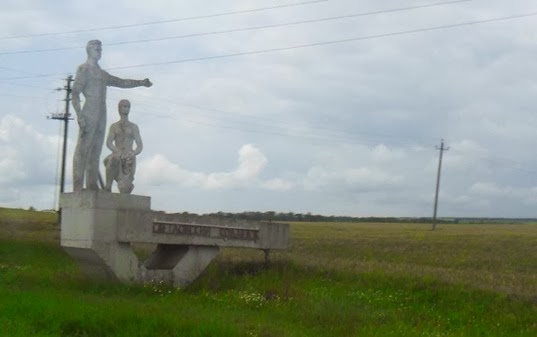 This is the way comrades! The sign for the Svetlovskii Collective Farm
This is the way comrades! The sign for the Svetlovskii Collective Farm
In the town of Congaz I noticed something else of interest. Every few hundred metres by the roadside were wooden wells, whilst less often but far more colourful, there were roadside shrines with beautiful carved crucifixes. What was obvious was that this region was both intensely religious and that they had no running water. Nowhere else in Europe have I encountered the latter.
The capital of Gagauzia is Comrat and whilst on the surface it appeared much like a thousand and one other impoverished small towns east of Berlin, when I looked a little closer, I did notice some small differences. All the notices were in three languages: Moldovan, Russian and Turkish and above some of the buildings flew an unfamiliar flag. Its top half is blue with three yellow stars whilst at the bottom are horizontal red and white stripes. It is the official flag of Gagauzia.
We stopped for drinks and a toilet break at Comrat Bus Station so I alighted in order to say that I have set foot upon the territory of Gagauzia. The bus station was new and a plaque on the wall declared that it had been the gift of US Aid. Better than bombs I suppose. Signs of Gagauz identity abounded from the flag on the roof to a poster map of the territory on the wall and many signs in the Turkish language. On the train to Odessa, Genaidy had said, with a hint of envy and mistrust I suspect, that Turkey has been pouring money into Gagauzia in an effort to promote the Gagauz identity and whilst there were signs of Turkish cultural influence, the only visible signs of new money – or indeed any money– in town were a new block of apartments and the bus station itself which, of course, the Americans had coughed up for. There are a few references on the internet to Turkish investment in the region including $35 million on Gagauzia’s roads, but judging from what I saw and the bumps that I endured on my journey through the province, I suspect that most of that cash has ended up in someone’s back pocket.
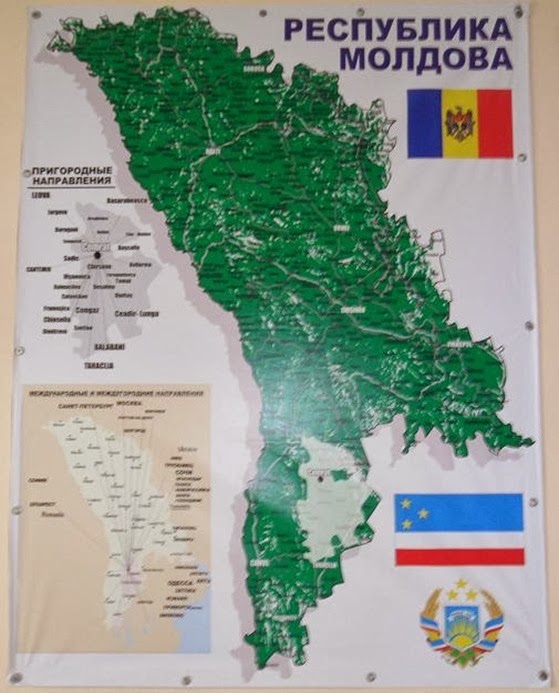 Poster on the wall in Comrat bus station. Gagauzia is the white area at the bottom of the map. Although not clear from this picture, it is actually divided into four separate sections, separated by predominantly Bulgarian villages
Poster on the wall in Comrat bus station. Gagauzia is the white area at the bottom of the map. Although not clear from this picture, it is actually divided into four separate sections, separated by predominantly Bulgarian villages
As for the locals themselves, did they display any noticeable differences to their neighbours? Well, they didn’t look Slavic, that was for sure and they were somewhat duskier than most of the Moldovans that I saw in Chișinău. Furthermore, everyone was speaking in a language totally incomprehensible to me, but to be fair, that could just as easily have been Moldovan as Gagauz.
The remainder of the journey up to Chișinău was more of the same, although nearing the capital the awful road turned into a highway and the vast plains evolved into more intimate folds and for the first time on my trip I beheld a landscape that I would describe as ‘European’.
The bus terminated at the Southern Bus Station, some several kilometres out of the city and I had to take a taxi to my hotel. At first I thought the fare of $6 to be perhaps a little steep but I hadn’t realised just how far the journey to Hotel Cosmos would be and in the end I realised that Moldova was a country that is extremely good value.
My only previous knowledge of Chișinău came from reading Tony Hawks’ hilarious travelogue ‘Playing the Moldovans at Tennis’ in which the British funny-man is watching a football game between England and Moldova which the English win 4-0 and the Moldovans are unbelievably rubbish. This causes him and his mate to have a debate on whether the skills from one sport can be passed onto another and Hawks to declare that, since he is reasonably good at tennis and the Moldovans toss at football, he could beat all the Moldovan football players at tennis. Naturally, such boastful claims must be proven and so the two men have a bet and Hawks jets off to Chișinău. His impressions of the city however, are far from positive:
However, the place that enfolded before my eyes on that taxi journey into the centre was quite different indeed. Built on a series of hills, Chișinău is lush and green and brimming with parks. We went past the university and some fine villas as well as a mammoth memorial to the dead of World War II before finally entering the centre and pulling up before the Hotel Cosmos, an immense twenty-odd storey concrete slab in front of the bus Pl. Negruzzi.
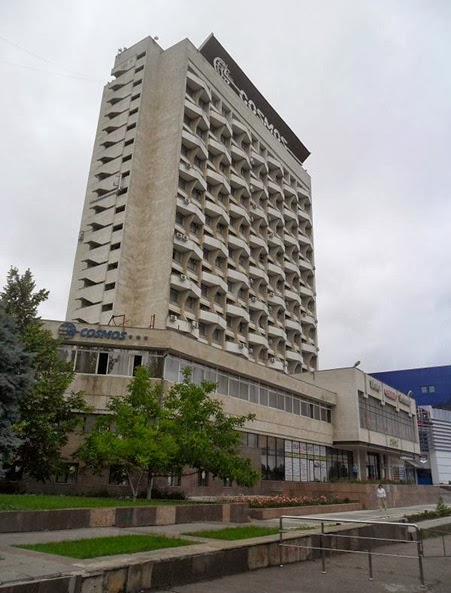 Journey’s end: Hotel Cosmos, Chișinău
Journey’s end: Hotel Cosmos, Chișinău
[1] Similar in size to Albania. As a comparison, Romania is more than seven times its size whilst Ukraine almost nine times bigger.
[2] Or as it is sometimes rendered in English, ‘Transnistria’ or ‘Trans-Dniestr’. Its Russian name is Pridnestrovian Moldavian Republic, (abbreviated to ‘PMR’ although often referred to as ‘Pridnestrovie’). The name literally means “Land beyond the River Dniester”.
[3] Incidentally, the city name is thought to be Nogai in origin, one of the few reminders of their presence.
[4] When I talk of Moldovan nationalism, I am referring to the nationalism of the majority Moldovan-speakers. Moldovan is essentially a dialect of Romanian and their nationalism stresses ties with their neighbour to the west, with many wishing for a full political union between the two countries.
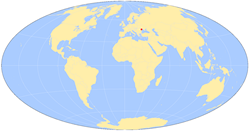
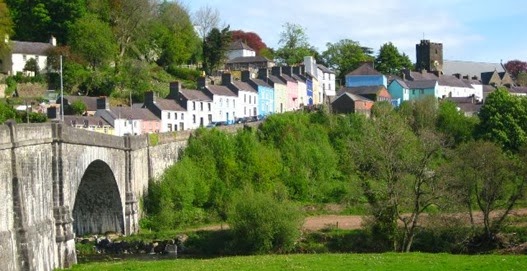

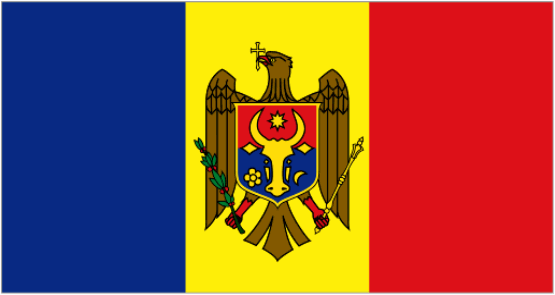

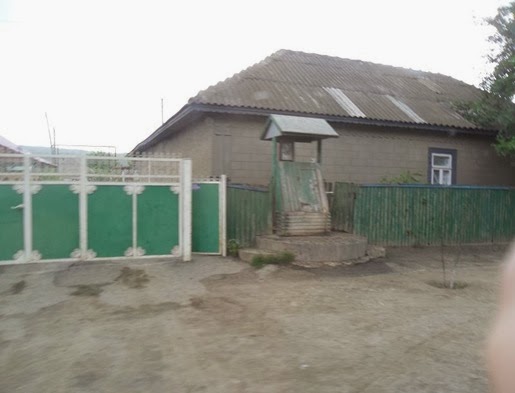

No comments:
Post a Comment